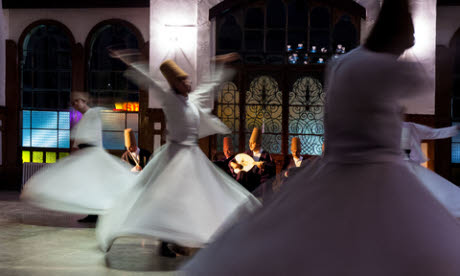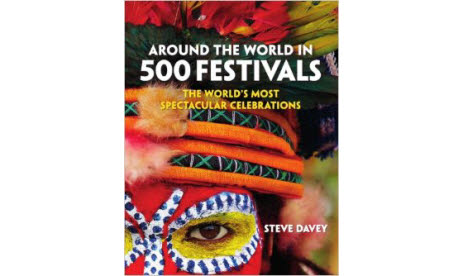
Sick of all the Christmas hype already? From the exotic to the eccentric, here's where to get a festival vibe without any festive tat in tow
This one’s a real winter warmer, based around the city’s Shinto shrine. Huge floats – weighing up to 20t – are on display at the 2,000-year-old Chichibu Shrine before being pulled through the streets up to the plaza in front of the city hall. Decorated with lanterns, tapestries and gilded wood, some floats are big enough to stage kabuki theatre. The climax, during which participants are guaranteed to work up a sweat, is when the floats are hauled up a steep slope to the plaza on the final evening. The reward is a spectacular firework display lighting up the winter sky.
Where: Chichibu City, Japan
When: 2 and 3 December
If you don’t like Christmas then head to Küssnacht on the northern shore of Lake Lucerne where you can chase down Santa Claus with a cowbell and give him a sound thrashing. Dating back to the medieval pagan ritual of scaring off evil spirits with noise, the practice was banned in the 18th century, only to be revived under the guise of a Christian festival featuring St Nicholas.
The night before St Nicholas’ Day the whole village turns out for a parade led by men cracking whips and wearing the characteristic iffele hats. These are translucent paper and card, ornamental headdresses in the shape of a bishop’s mitre, which are lit by candles giving the village a warm glow. Next comes a man dressed as St Nicholas, who is chased and beaten by up to 500 people carrying cowbells and horns. It’s perfect revenge for the time you didn’t get the bike you wanted for Christmas.
Where: Küssnacht, Switzerland
When: 5 December
The playful chaos of this piebald festival dates back to a slave revolt in 1607, when rebels demanded a day off and were granted the fifth of January. To join in the fun, the slave owners painted their faces black. The slaves responded in kind the next day by whitening their faces with powder.
Revellers can expect to be smeared, dusted or painted in something black or white during the lively Carnaval de Blancos y Negros. The custom has been cheerfully carried on ever since, with everyone in the city covering everyone else with chalk, grease, flour or talc. The entire carnival lasts from 28 December to 6 January, but the last two days are the most eventful, when revellers runs wild, blackening and whitening each other on subsequent days. Don’t think that you can avoid joining in – everyone gets covered in something white or black, whether they like it or not.
Where: San Juan de Pasto, Colombia
When: 28 December to 6 January
When you live in as remote and inhospitable a place as this, you deserve to treat yourself with a winter knees-up. The Kalash minority people of north-west Pakistan inhabit three remote valleys near the border with Afghanistan. For two weeks around the winter solstice, they celebrate the end of the harvest by drinking mulberry wine, dancing and feasting on goats they have sacrificed.
The Kalash are animists and believe that at this time of year their god Balimain comes to dwell among them. To show their strength and unity, they make model animals from pastry, which the children then ‘hunt’ by throwing stones at them.
Where: Kalash Valleys, Chitral, Pakistan
When: Two weeks at the winter solstice
The Degwal, or ‘crossing of the cattle’, when herdsmen lead their cattle across the river to new pastures, has been celebrated at Diafarabé since the founding of the village in 1818. During the one-day event, local herdsmen compete for the Best Caretaker Prize, awarded for the fattest and healthiest cows. More than a simple contest, though, the Degwal offers nomadic herdsmen the opportunity to reunite with their families and catch up with local news. It is also a prime time for courtship, when unmarried men and women can put on their Sunday best and vet potential mates during the popular Promenade des Jeunes.
Where: Diafarabé, Mali
When: A Saturday in November or December, depending on the rains
This most Islamic of Turkish cities is home to the spellbinding Whirling Dervishes of the Sufi Mevlevi Order, founded in the 13th century by followers of the Sufi mystic Mevlana, also known as Rumi. The order became famous for their ritual prayer – performed spinning on one foot – during which they enter an ecstatic trance. Although the fraternity perform throughout the year, they gather for a week in December in the city’s sports stadium to dance in celebration of their founder. The climax of the festival is the final night, on 17 December, when the dancers celebrate the anniversary of Mevlana’s wedding night – a mesmerizing spectacle of perfectly coordinated movement, with the dancers’ white skirts lifting to form spinning discs.
Where: Konya, Turkey
When: December
In a breathtaking twist on pole-dancing, a pair of Guatemalan daredevils climb a 30m pole and leap off – precariously attached to the pole by nothing more than a rope around their ankles. As the voladores (flyers) plummet headfirst, the rope attached to their ankle unwinds from around the pole, spinning them safely to the ground. After these nail-biting antics, a party atmosphere spreads through the city with parades of revellers clad in Mayan masks and costumes.
Fusing both native and Spanish Catholic traditions, the fiesta welcomes the Mayan winter messenger Olentzero while also honouring Santo Tomas on the last day of festivities.
Where: Chichicastenango, Guatemala
When: The week leading up to 21 December
A sort of Saharan Mardi Gras, the Moussem of Tantan is easily the most eagerly awaited gathering of nomadic desert peoples in North Africa. Up to 30 different Arab Bedouin tribes are drawn to the small desert town of Tantan not only to celebrate, but also to preserve Bedouin customs and culture. Lines of camel-wool tents exhibit a surprising array of local metal and leather handicrafts, Saharan culinary arts and even herbal remedies. Outside, dancers swirl and stomp in dazzling dress, while virtuoso riders perform acrobatic feats at full gallop.
Where: Tantan, Morocco
When: December
Many people use the lull between Christmas and New Year to visit relatives, hit the sales or generally sleep off the festive excesses. In the town of Ibi near Alicante local married men throw a massive flour and egg fight. One group, the Els Enfarinats, dresses up in mock military uniforms and stages a ‘coup’, taking over the town and instituting a series of bizarre laws. They catch any miscreants with a net and fine them for charity. Another group tries to overthrow the new rulers and battle ensues. The festival is said to date back 200 years. Though its precise origins are unknown, it falls on 28 December, which is the Feast of the Holy Innocents, a day traditionally celebrated in Spain and Latin America with childish pranks (inocentadas).
Where: Ibi, Spain
When: 28 December
Although it gives every appearance of a tourist event created by the local agricultural board, the Noche de Rabanos (Night of the Radishes) has been staged in Oaxaca’s main plaza during the Christmas Vigil market since 1897. Venerating the humble radish, which was brought to Mexico by the Spanish in the 16th century, the event showcases radishes that have been sculpted by craftsmen. Many represent seasonal themes, such as the Nativity, but some portray national celebrities. To be large enough for sculpting – up to 50cm long – the radishes are harvested late. Although the event lasts only a few hours, it is a unique ode to a humble vegetable, attracting thousands of visitors every year.
Where: Oaxaca, Mexico
When: 23 December
One of the last surviving mass ceremonies in Africa, Incwala, or the Festival of the First Fruits, unites the people of Swaziland in an eight-week festival that welcomes the harvest, invokes ancestral blessings and renews the power of the king. While the king retires to meditate in the royal palace, young men trek more than 37km to gather ceremonial branches from the sacred Lusekwane bush, whose telltale leaves apparently wither if touched by impure hands. On the third day, warriors slaughter an ox and dance the inczuala near the royal enclosure, encouraging the king to emerge. Eventually he comes out in full regalia, performs a sacred dance and, in a symbolic gesture, tastes the first pumpkin of the harvest. The New Year harvest party can then start in earnest, with joyous feasting, music and dance.
Where: Royal Kraal, Swaziland
When: Late December to January, set by the moon
 These 11 festivals have been taken from Steve Davey's new book Around the World in 500 Festivals (published by Kuperard, as part of the Culture Smart! series). Find out how you can get your hands on a FREE copy here.
These 11 festivals have been taken from Steve Davey's new book Around the World in 500 Festivals (published by Kuperard, as part of the Culture Smart! series). Find out how you can get your hands on a FREE copy here.